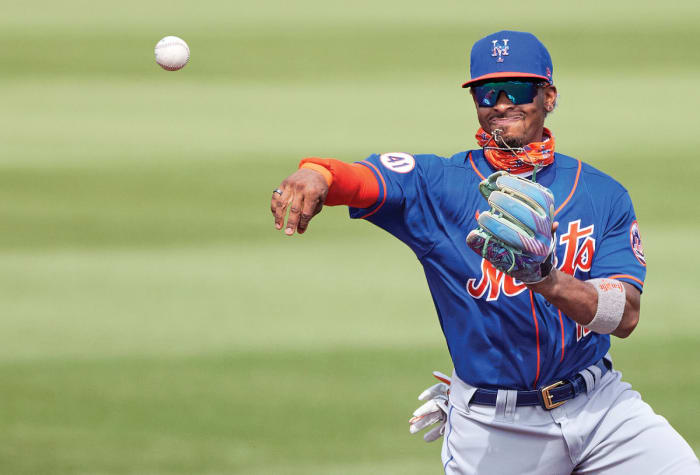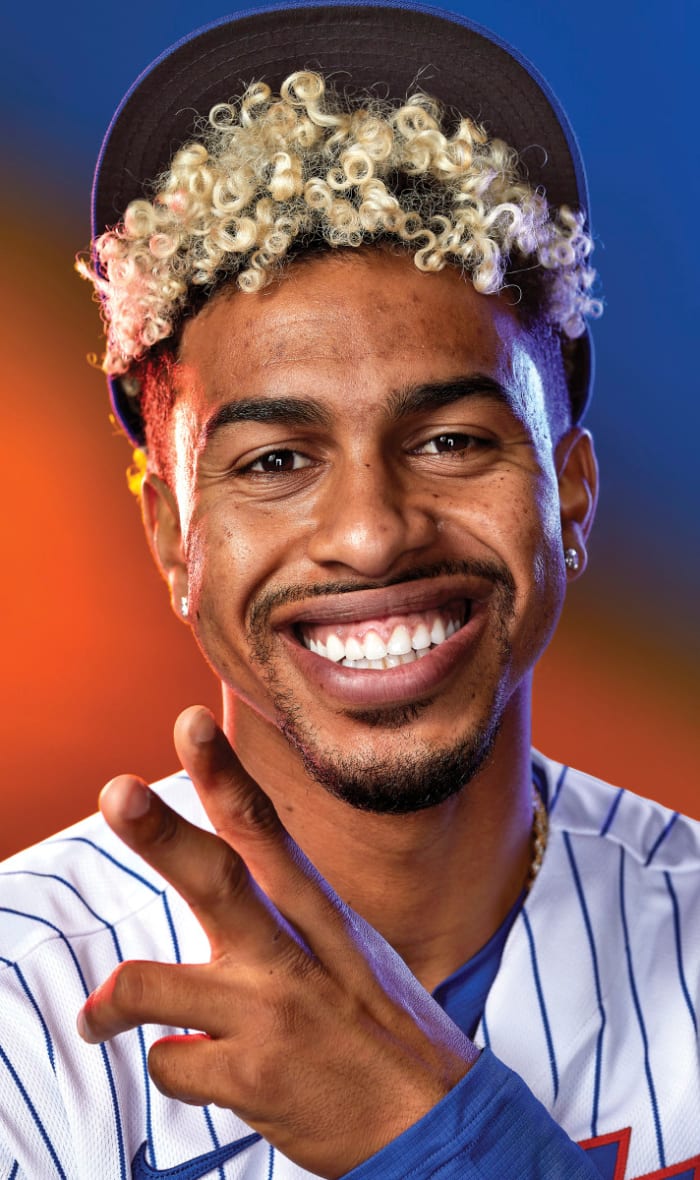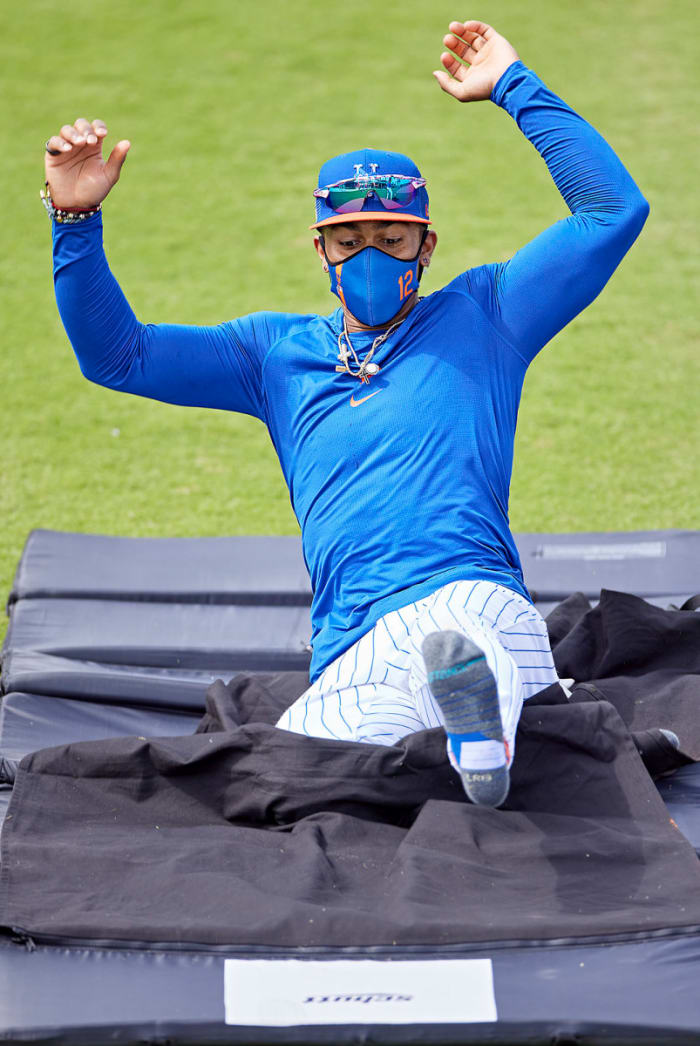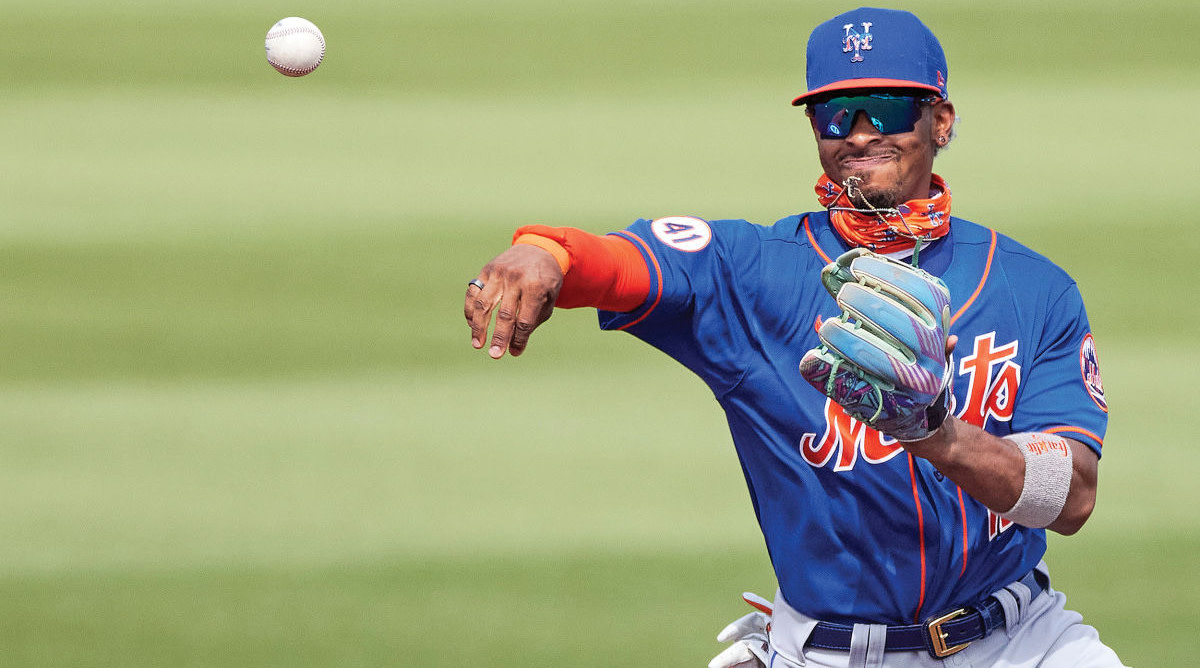
In the Golden Age of Shortstops, Francisco Lindor Is the Crown Jewel
Glorious sunshine, 80° heat and a sleek Porsche 911 GT3 RS in fashion gray with a cinnamon-red leather interior greets Francisco Lindor as he strolls from lunch at the Bella Collina Club in Montverde, Fla., where the hilltop clubhouse was built, stone by stone, as an exact replica of a castle in Tuscany. Lindor is on his way to see a school building named for him—just 10 years after he was a student there. Only an orchestra in the parking lot playing Debussy, the painter of dreams, could have completed the serenity of the tableau.
Until the damn car will not start.
Lindor turns the key. Nothing. Not a click, a groan, a grind or the even the smallest hint of operational hope. Only mocking silence.
What happens next opens a window into why Lindor is the best hope not only to end the Mets’ 35-year championship drought but also to rescue baseball from its technocratic reductionism that promotes probabilities over athleticism, efficiency over entertainment and data over humanism.
Lindor laughs. The man they call Mr. Smile lights up with the wattage of joy that Lewis Carroll had in mind when he invented the word frabjous.
“It’s because of the sun!” Lindor says. “It gets hot when I park it in the sun and just decides, I don’t want to go. Can you believe it? You spend 300 grand on a car, and it doesn’t want to go when it’s hot. That’s kind of a problem when you live in Florida!”
Lindor meets misfortune with a smile. He doesn’t do petty anger. Nor does he do those paint-by-number, laminated defensive positioning cards teams stuff in players’ back pockets, or endorsements of defensive shifts, or cookie-cutter methods to field a ground ball or anything else that stifles the creativity of ballplayers. He laughs at convention even more than at a temperamental $300,000 sports car that refuses to start.
Under new management from owner Steve Cohen and president Sandy Alderson, the Mets signaled their elevated intentions by swinging a blockbuster offseason trade with Cleveland for Lindor, a singular talent and personality. The Mets also obtained righthander Carlos Carrasco in the Lindor deal and off the free-agent market signed pitchers Taijuan Walker, Trevor May and Aaron Loup, catcher James McCann and outfielders Kevin Pillar and Albert Almora Jr.
Lindor provides New York an enormous upgrade over erstwhile shortstops Amed Rosario and Andrés Giménez, who were sent to Cleveland in the deal. New York shortstops ranked 21st in OPS and 26th in defensive runs saved last season. Defense has been the club’s most corrosive problem while falling 33 wins short of Atlanta during the Braves’ three-year hold on the National League East. Since 2017, New York has ranked 30th, 27th, 28th and 28th in defensive runs saved.
The Braves, Dodgers and Padres also bulked up this winter to make for an intense pennant race, but no move was more jaw-dropping than Mr. Smile’s coming to Broadway. Lindor relishes the pressure that comes with parachuting into a championship-starved New York.
“To know I’m going to an organization that can put team after team after team together, that’s exciting,” he says. “It’s also exciting to play in New York. It’s New York. Every player who goes to New York gets excited to play, whether you’re home or away. I love it. I love the fans screaming whether they are against you or for you.”
New York is getting the only American League shortstop to win a Platinum Glove since 2011, when the award for the best fielder in each league was first handed out. Though just 5' 11" and 185 pounds, the switch-hitter also belted more homers before his 27th birthday (last November) than every shortstop in history except Cal Ripken Jr. and Álex Rodríguez.
The home runs, though, do not come to mind when he is asked what he loves most about baseball. Lindor thinks for about five seconds, then says, “I love making great plays. I love that. But also, the ups and downs. Finding that balance of being humble but confident in your craft.
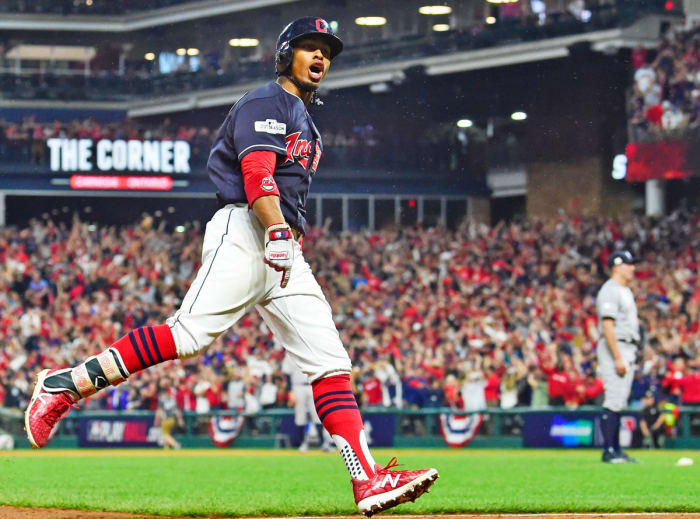
POWER PLAYER: In Game 2 of the 2017 AL Division Series, a year after batting .310 for Cleveland in the World Series, Lindor belted a grand slam to help erase a five-run deficit in a 9–8, 13-inning win over the Yankees.
Jason Miller/Getty Images
“If a person sees me wrong because I have a $3 million home, that’s their fault. I’m still the same person. And it’s the same thing in the game. I’m smiling. I’m having fun. Because that person plays the game mad or serious or has no emotions or controls his emotions better than I do, it doesn’t make me a bad baseball player or a bad person.
“The life lessons within the game are huge. I try to live my life on being consistent and staying positive. If I do that in the game and in life every single day? I’m a great human being. I’m a great baseball player.”
The smile hides the adversity he has endured. The frightened 12-year-old who spoke no English when he left Puerto Rico to attend school in Florida, where his family of five crammed into a small pay-by-the-week motel room with only a microwave to prepare meals. The strict father who depended on government assistance after he had to quit work because of panic attacks brought on by PTSD. The developmentally disabled younger stepsister, Jezabel, who can neither walk nor talk with cerebral palsy. The older sister, Legna, who was diagnosed at age 32 with cervical cancer. The mother, Maria Serrano, who suffered an aneurysm last September.
Yet none of those hardships have soured Mr. Smile. One does, though. Ask him about the direction of the game, and you understand why Lindor joined the executive board of the MLB Players Association.
“I do worry,” he says. “I worry that we won’t have the freedom to play the game the way we want to play the game. . . . I was worried that the game was going to go to so much analytics that it was going to take over it. Well, it took over. You saw it in the World Series.
“Now it’s like I have to look in the dugout to know where to play. They take starting pitchers out in the third inning. They do matchups according to computers. The front office is managing. You see GMs making more money than managers. That should tell you who is running the team. I just want the freedom to play the game.”
Francisco Lindor wants to save the game, one smile at a time.
If analytics call for the removal after only 73 pitches of the first pitcher in World Series history with nine strikeouts while allowing only two base runners, what more governors will be placed on ballplayers? The irony is that just as restrictions tighten in the name of efficiency, the majors are enriched with the most dynamic, deepest class of freewheelingly great shortstops ever.
Shortstop traditionally has been a glove-first occupation, with occasional outliers who could hit for power. Until 2018, only once, in 1947, did shortstops collectively bat better than the major league average, as measured by adjusted OPS. Now, for three years running, shortstops have outhit the league average. In just a 60-game season last year shortstops launched more home runs than they did in every year through 1986.
Today’s group features six shortstops with a career slugging percentage better than .470 through age 27 (minimum of 300 games, at least half at the position): Trevor Story of the Rockies, Corey Seager of the Dodgers, Lindor, Carlos Correa of the Astros, Trea Turner of the Nationals and Javier Báez of the Cubs.
That is as many such slugging young shortstops as there had been in the history of the game before they arrived.
Moreover, Gleyber Torres of the Yankees (still with more games at second base), Fernando Tatis Jr. of the Padres (143 games) and Bo Bichette of the Blue Jays (75 games) are on track to join them, while Paul DeJong of the Cardinals, Xander Bogaerts of the Red Sox and Tim Anderson of the White Sox fall just below the .470 threshold.
The two highest collective OPS seasons by shortstops have occurred in the past two years (.772 and .748), displacing the 2006 group (.740), which included Derek Jeter, Hanley Ramirez, José Reyes, Jimmy Rollins and Miguel Tejada. Today’s shortstops are changing the game by being so good so young.
“There is a more recent trend to move guys [through the minors] more quickly and trust that their athleticism will allow them to make adjustments,” says Blue Jays president Mark Shapiro, who drafted Lindor for Cleveland in 2011. “When I started, it was more formulaic. It was 2,000 plate appearances [in the minors] and making sure guys didn’t skip a level. Now it’s more about one, the mental approach—and that’s elite with Frankie–and second is athleticism.
“There is something in Francisco Lindor that is different than most players: He wants to be among the greatest. You combine that with intelligence and elite athleticism, and that’s why he’s going to impact the game for years.”
The Padres recently signed Tatis, just 22, to a 14-year, $340 million contract. Only outfielders Mike Trout ($426.5 million) and Mookie Betts ($365 million) have deals of greater value. Story, Seager, Correa, Lindor and Báez all entered spring training as potential free agents after this season. (Lindor indicated he was open to negotiating an extension with New York until Opening Day.)
“Given my choice of all of them, I’d take Lindor,” says one National League executive. “Because of his age and his body, his chances of being a high-level defender at that position for the next five, six, seven years is pretty high. His floor is pretty high. And if he can still be a 30-home run hitter, he’s annually in the discussion of the top five players in baseball.”
As a rookie in 2015, Lindor hit .313 with 12 home runs. He followed that by hitting .301 with 15 home runs in ’16.
“The next year [2017] I was like, ‘F--- that. Turn on the ball,’ ” he says. “I hit my .273, 33 home runs, Silver Slugger. All of a sudden it’s, ‘Wow, he’s a great shortstop.’ I sacrificed my batting average for home runs.”
Ask Lindor who is the best shortstop and you get honesty, not diplomacy.
“Overall? Me,” he says. “Because I will do it every single day. I count on myself every single day. Every single day. Trevor Story? I love watching him. We talk hitting and defense. The best hands at the shortstop position right now are Freddy Galvis and Andrelton Simmons. Best hitter? When Seager is at his level I think he’s the best hitter.
“If we go tool by tool, plenty of them are better than me. Tatis? He’s incredible. And Báez? I’ve been playing against Báez since I was growing up and it’s like, ‘Bro, how are you doing this?’
“There’s that fine balance between being confident and being cocky. Sometimes for me it’s hard to admit to myself who is the best shortstop. Why? Because of that fine balance. I’m confident. I think I’m the best shortstop.”
Confident? Lindor kept betting on himself in terms of his value. He resisted overtures from Cleveland to sign an early contract extension. “I was never opposed to it,” he says. “It just had to make sense. Three-forty makes sense. Back in the day maybe 240 makes sense.” Lindor will earn $52.3 million through his six service years of club control. Tatis, because of the way his long-term contract is structured, will make $35 million in that same window.
Confident? On one of his first days in a New York uniform Lindor walked into the spring training facility at Port St. Lucie, Fla., with blue hair, his Lindor 1 New Balance sneakers (which he helped design, insisting the line include a multicolor unisex version) and a replica of the Mets varsity jacket worn by Eddie Murphy in Coming to America.
“I think he doesn’t like to look bad, which is why I think he’s such a good fit in New York,” says Jason Kipnis, his former double-play partner in Cleveland. “He wants everybody to like him. To love him. He wants to be the big superstar. It’s like the jacket he wore. He’s going to play the part.”
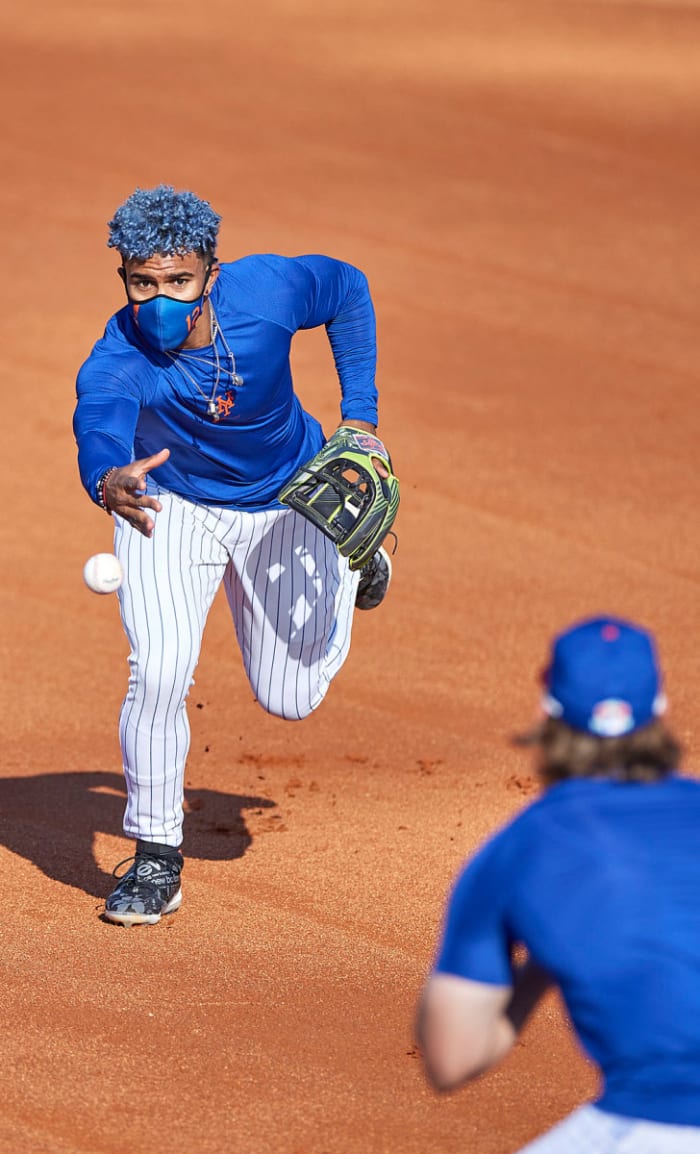
GREAT EXPECTATIONS: Embracing the move to the Big Apple, Lindor has instilled optimism in spring training, which has been in short supply during New York’s 35-year championship drought.
Simon Bruty
Genius bows to no boundaries. Van Gogh painted Starry Night while in a sanitarium. Lindor learned how to field grounders freelancing from the bottom of a hill. His father, Miguel, would stand halfway up the small incline next to their home in Gurabo, P.R., with a bat and some yellow rubber balls. Francisco and his brother, also Miguel, and cousin Christian Figueroa, both nine years older, waited at the bottom. Behind them was a thicket of bushes. Letting a ground ball get by meant having to wade into the thicket to find it.
The hill and the bounciness of the rubber balls assured tricky hops. Miguel hit grounders to their left and right more than he hit straight at them. He taught them to attack the ball, to catch it with one hand and to improvise.
“Make things happen,” Lindor says. “You go get the ball. You keep the ball in front of you. You do whatever you can. And fight. Fight for it. This hand?”
Lindor raises his throwing hand. “If it was a bad hop, you either get your face out of the way or you catch it with your bare hand. I’ve been using that my whole life. Here in the United States, it’s two hands. My dad always said one hand.”
Asked whether his father was strict, Lindor nods and says, “Still is. My dad thinks I’m playing Little League.”
He hears from Miguel after every game via text.
“A paragraph,” Francisco says. “‘You’re doing this, you’re swinging up, you’re not catching the ball the right way . . . ’ I’m like, Pops . . . ”
The 2017 All-Star Game was in Miami, allowing Miguel, who lives in Florida and does not travel by air, a rare opportunity to see his son play in person. Lindor faced Zack Greinke and Greg Holland. He struck out both times. His dad texted him.
“For that? I came here to Miami to see that?”
The son texted back, “Pops, it’s an All-Star Game. What are you talking about? Do you know who I faced?”
Says Lindor, “I guess it’s a good thing because he keeps me true to myself. His criticism hurts me more than anybody else’s, because his is the one that matters. It comes from a good place, which is my pops. I love him.”
When Lindor was 12 his father moved the family to Orlando so that Francisco could attend Montverde Academy and that Jezabel, who was eight at the time, could receive better medical care. An arrangement for Francisco to board at the school fell through, leaving his father; his stepmother, Mari Rivera; Francisco; his stepsister, Jezabel; and his toddler sister, Angela, to live in a $100-a-week motel room on Route 192, 45 minutes from the school. Francisco slept in a top bunk with his nose close to the ceiling.
On the drive to Francisco’s first day of school, Miguel quizzed his son on the English words they had practiced in Puerto Rico. Francisco remembered almost none of them. He could not grasp the phrase, “I don’t understand.” Miguel stopped the car.
“Give me your hand.”
Francisco opened his palm. Miguel grabbed a pen and wrote on it, “I don’t understand.”
“There,” he said. “When you don’t understand something, just show that to people.”
Francisco would call his mother in Puerto Rico and cry into the telephone because the math textbooks made no sense.
“You’ll be fine,” she said. “You can do it. Keep on pushing.”
“I was scared,” Lindor says. “It’s not that I felt I was in the middle of nowhere. I was in the middle of nowhere. I was like, Where am I? It was difficult the first three or four days. And then you start going to baseball practice.”
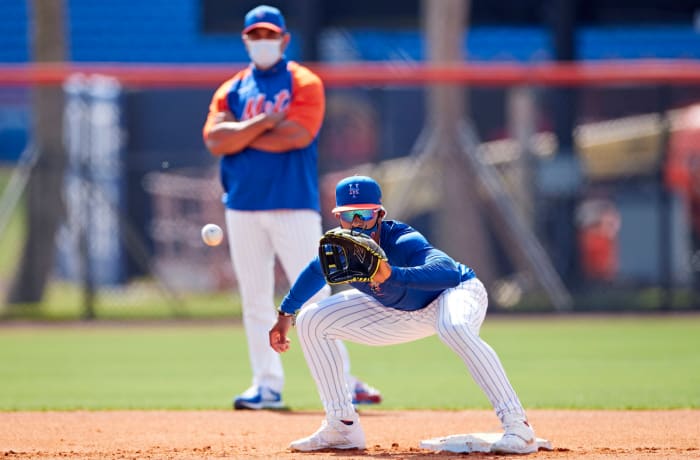
D ESCALATION: More than anything, Lindor’s gifted glove is what the Mets need: He ranked eighth among shortstops in defensive runs saved last season, a category in which New York finished 28th.
Simon Bruty
Lindor, who became a boarder at the school after two months of commuting, was determined to be a major leaguer. The idea of being on television motivated him. “I thought I came here to play the game,” Lindor says. “I didn’t need English to play the game.”
He flunked the introductory level of English as a Second Language. His friends moved to ESL II. Lindor repeated ESL I. He was the only one in the class.
“I looked around and thought, I’m the dumb kid,” he says. “I didn’t like school. I wasn’t going to do schoolwork then—until they said, ‘Well, if you don’t do your schoolwork, you can’t play.’ I said, ‘O.K. I’ve got to study first to be on the field. I got it. I’ll do whatever it takes to be on the field. Cool.’ That helped me understand there is a process to everything. I have to get that done first to be successful somewhere else.”
By his senior year Lindor was one of the top prospects in the nation. So was Báez, who like Lindor had left Puerto Rico for Florida at age 12. When their two high school teams met for a game that February, 110 scouts and executives attended.
“One thing that stood out about Lindor was that right away you said, ‘There’s no doubt this guy can play shortstop in the big leagues,’ ” says Josh Byrnes, then the Padres’ senior vice president of baseball operations. “He had gifted hands. And when you did the background work on him you found out he had a relationship with his special needs sister that was pretty significant. He wasn’t just a high-energy player. He was a high-class person.”
Says Lindor, “Seeing [Jezabel] reminds me, ‘You’re in a much better position. No matter what, don’t complain. Don’t complain. You’ve got your health? You’re fine.’ And she’s a happy girl. She smiles a lot. But it’s like, ‘Don’t complain. You’re good.’ ”
Picking 10th in the 2011 draft, the Padres rooted for Lindor to fall to them. Cleveland selected Lindor eighth. The Cubs grabbed Báez with the next pick. The Padres took infielder Cory Spangenberg.
“Báez was getting a little more attention,” Shapiro says, “but Lindor stood out from a makeup and character standpoint. Analytically, even though we didn’t have a lot of analysis because he was so young, he profiled well in our model.”
Lindor agreed to a $2.9 million signing bonus just one minute before a midnight deadline that would have sent him to a junior college.
“I had no fear. I trust the process,” he says. “My dad is on the couch like desperate. ‘Oh, my God. What are you doing?’ I’m like, Pops, it’s O.K. If God wants me to play the game, I will play the game.”
Lindor was staying at a hotel in Arizona during Instructional League when the direct deposit cleared. He saw the net amount in his online statement: $1.45 million.
“I looked outside my hotel window and I saw a Best Buy,” he says. “I walk in, I see an iPad and I said, ‘I want that one. That color. Just sell me that.’ I bought it and went back to my room. That was the greatest thing ever.”
Lindor also used the money to buy homes for both his parents. (His mom, Maria, now lives across the street from him in Clermont, Fla., and, he says, is recovering from the aneurysm.) He also bought something else for himself in addition to the iPad: braces.
“My dad always told me my teeth were fine,” he says. “I was like, Dad, they’re jacked up. We didn’t have money to pay for them. Growing up I did smile a lot, but not in pictures. In pictures I had a half-smile. When I got back home, we had the house and I got braces. It changed my life. I was like, I’m good.”
Professional baseball wanted to change Lindor, and, as a teenager eager to please, he allowed it. When he began fielding ground balls with the one-handed, attacking style his father taught him on the hill, he felt the daggers embedded in the sideways glances he got. Some coaches told him to use the standard U.S. method: throwing hand and glove forming a version of a gator’s mouth closing on the baseball, followed by the hands funneling toward the belly, then throwing with an overhand motion.
“That’s just how they were taught,” Lindor says. “And they had success with that so that’s all they know. ‘Gator, funnel, throw.’ If I’m running forward and I’m catching a ground ball, I ain’t going to funnel. Get rid of it!
“ . . . Here? The game is played a certain way. When I came here using one hand I was ‘hotdogging the game. I’m a hot dog. I’m cocky.’ Then I started using two hands because I needed to make sure people didn’t see me like that.
“I went through a process where I didn’t want people to see me as this cocky, arrogant Puerto Rican that is coming here to play the game. I want people to see me as someone who respects the game. Somebody that’s a good person. And through that process as I got older, if I’m flashy it doesn’t mean I’m disrespecting anybody.”
Says the Dodgers’ Byrnes, “These shortstops have changed the expectations of what you can get out of the position. They can dominate both halves of an inning. I think it filters down to high school fields, where kids trying to get drafted now have higher expectations of what a major league shortstop can do.
“Baseball helped Patrick Mahomes with the way he throws. We preach to our infielders that you have got to be creative. It’s O.K. to catch one-handed. It’s O.K. to play different positions. You need athletes playing that position.”
Lindor admits he may have the weakest arm of the elite shortstops, but he plays one of the deepest shortstops because he is so quick. Last year he played four to six feet deeper than Rosario, who was included in the six-player trade to get Lindor.
He also has an uncanny knack for reading pitchers’ stuff and hitters’ mechanics. For instance, he talked about how a tiny front-shoulder movement of Royals catcher Salvador Pérez on certain pitches gives away where he is going to hit the ball.
“That’s how I go with my defense,” Lindor says. “I watch mechanics and swing path and understanding my pitcher.”
Those ubiquitous laminated cards teams use to tell fielders where to position themselves? Lindor has no use for them.
“Helllll no!” he says. “No. No. No. I think I’m smart enough to remember nine hitters and 10 pitchers. And nothing against the people that use it. I’m going to rely more on my instincts than a card. And they’re pretty accurate.”
Lindor has no use for defensive shifts, either. Since he debuted in 2015, the use of shifts has more than tripled—from 10% of pitches to 35% last year. In that same time the difference between batting average on balls in play facing a shift and facing a standard defense went from a 17-point reduction to a 28-point reduction. If it were up to Lindor, a team could not station more than two infielders on either side of second base.
“The shift has got to be cut down,” he says. “Let me do me. Let me make the crazy play. Let me be like, ‘O.K., he’s going to pull the ball. I can’t be on that side of the base.’ So as the pitch goes, I run on the other side of the base—pow!—and make the play.”
In addition to banning the shift, Lindor wants to use his position with the MLBPA to find ways to:
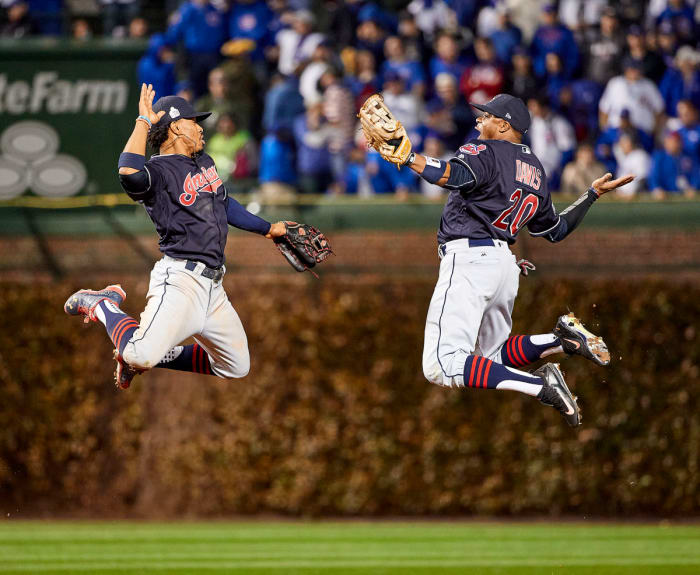
SOAR SPOT: Lindor (with Davis) was an uplifting force in his six years in Cleveland: four All-Star appearances, two Silver Sluggers, two Gold Gloves and one Platinum Glove, all by the age of 26.
Al Tielemans
• Allow teams to profit from their stars. “You’re telling me you sell a jersey outside the stadium and the team only gets 3%? Because they’ve got to split it with everybody else? Split it with Pittsburgh? Split it with Tampa, which doesn’t want to spend money? Split it with the Indians, who don’t want to spend money? That’s not fair to a team in New York and not fair to a team in L.A. What are they going to do with 3% of $150? Go buy some coffee?”
• Incentivize winning. “ ‘Oh, you finished last in the league. We’re going to give you money.’ Because of the luxury tax, these teams that didn’t want to spend money, they send them money for next year.”
• Market the game—and its players—more aggressively. “We can’t market the shift. We can’t market strikeouts.”
• Give players a voice in how the baseball plays. “It drives me crazy that the game of baseball is the only game that you can change the ball and nobody can say anything. It drives me crazy.
“ . . . Make the ball where it spins good for pitchers and it’s good for hitters. Get us all in one room. Let us talk about it. Don’t be sneaky about it.
“And that’s why I am part of the association. I want to be fair. I want to be in the situation where I can help others, especially the Latin players. Let’s find a way.”
With the Porsche deciding it was too hot to move, Lindor hitched a ride from a friend in her Dodge SUV to Montverde Academy, where for the first time he saw lindor hall above the main entrance to the middle school building. It is a short walk from Lindor Field. After donating money to refurbish the baseball diamond in 2013, he made an even more generous gift to help build a state-of-the-art middle school building replete with an all-purpose gymnasium, student lounges and three large science labs. “We had one tiny lab when I went here,” he says.
An extrovert, Lindor comes by leadership naturally. Growing up everybody called him Pacquito, the diminutive of Francisco. His older brother and cousin were constantly goading him to round up other kids to play basketball and baseball. “They’d say, ‘Go talk to that person,’ and I’d go over there,” he says. “I’ve always been a go-getter.”
That is why Game 7 of the 2016 World Series gnaws at him. Lindor was 22 years old. It already had been a very good day. Just before the game his older sister Legna called to tell him she was cancer-free after being diagnosed earlier that year. Cleveland and the Cubs were tied after nine innings. Cleveland held the momentum after a game-tying two-run home run by Rajai Davis in the eighth inning. Then rain stopped the game. Everything changed. The Cubs regrouped in a players-only meeting called by outfielder Jason Heyward. When play resumed, Chicago immediately rallied for two runs against Bryan Shaw, who was working his second inning, and held on for an 8–7 win.
“I went to the locker room [during the rain delay] and I saw the plastic and I said, ‘Oh, s---,’ ” Lindor says, referring to the protective sheeting to shield players’ lockers from the anticipated champagne celebration. “So I went down to the weight room and I just laid down for a nap. I was 22. If I was older, we would have won that game. It would have been different.
“Not that I would have gotten the team together, but I would have gone to [first baseman Mike] Napoli. ‘Hey, Nap. What do you think?’ Like, I was just happy to be in the World Series. ‘Hey, Nap’—because he was our team leader—‘hey, Nap, bro, we’ve got to find a way to do something different.’ Or, ‘Rajai, what you got? Let’s do this. Let’s do something.’ ”
Says Kipnis, “As riveting as any words may have been, I don’t think it’s that simple. It’s not like we let our guard down.”
Three years later, when Cleveland pitcher Trevor Bauer heaved a baseball over the center field wall upon being removed by manager Terry Francona, Lindor spoke up.
“I’m like, I can’t wait to go inside, because I won’t do it in front of people,” Lindor says. “I told [Bauer] from A to Z. I told him everything. Every word I could find in English I told him, and probably doubled up in Spanish, too. And he took it. Like, ‘You’re right. My bad.’ ”
Life is moving fast. On Nov. 4, Lindor became a father for the first time; his girlfriend, Katia Reguero, gave birth that day to a girl, Kalina. On Dec. 27 he proposed to Reguero in their backyard. On Jan. 7 the couple announced their engagement; that same day he was traded to the Mets. On Jan. 29 he closed on a 6,502-square-foot lakefront estate in Montverde for $2.9 million. Baby, engagement, trade, new home, a school building named after you. And how was your offseason?
If there is one mantra to guide Lindor through this loud, full life of his it is found in the two letters stitched into the leather of his outlandishly colored fielding gloves: BC.
“Be consistent,” he says. “It’s from my dad. My dad always said, ‘Be consistent. Whatever you do, be consistent.’ ”
Kipnis, asked what impressed him most about Lindor during their five seasons together, says, “His consistency at such a young age. You won’t find many players who had such a grasp on routine and what it took to get ready to play a major league game. He is so in tune with his body and what he does on the field.”
The sight of Lindor Hall brings out the famous Lindor smile. But he has done more than provide a financial gift and his name. Lindor funds a scholarship program that awards tuition grants to students. (Boarding costs at Montverde run close to $53,000.) He reads applicant essays and meets with the winners. He runs free clinics at the school and two years ago purchased uniforms and cleats for the baseball team.
“I do it because we have an opportunity to shape them into the man or woman they are going to become,” he says. “Because the structure I had at this school and the life lessons I learned I apply today. I can be a better person and I can help kids. That to me is the biggest compliment in life. Because everything I learned, I learned from somebody older than me. Besides my parents, school shaped me into the person I am today.”
That frightened 12-year-old who spoke no English returns to campus often (he trains there in the offseason), only now as a father who relishes leadership and the cauldron that New York can be. “I can’t wait,” he says. “I’ve talked to countless people about the city and they’ve said, ‘Be you. Be real. Give them everything you’ve got, and they’ll respect you.’ ”
As he moves about the campus in jeans and a T-shirt, Lindor seems more student than superstar. He is still Pacquito, the motormouth kid who will talk to anyone. As students move between buildings, he fist bumps a basketball player and asks him about his grades. A baseball player shows him a new bat. Lindor examines it for weight and feel as if it were gold. Then he walks by a group of students he knows, including a nephew.
“Hey, you, why aren’t you in class?” he calls out to them in mock anger.
He wheels and picks up an orange traffic cone, lifting it to his mouth as a megaphone. He shouts through it in the direction of a school safety officer across the street.
“Officer! These kids are cutting class! Take them to the principal!”
As Lindor puts the traffic cone down, everyone within earshot turns to see which mischievous student is causing such commotion. Nobody is laughing harder or smiling more broadly than Pacquito.
MUSCLE UP THE MIDDLE
Many shortstops in today’s game mash the way corner players traditionally have. Here are the seven active shortstops with the highest career slugging percentages compared to the Hall of Fame non-shortstops whose slugging stats are most similar at the same age.
VS.
VS.
VS.
VS.
VS.
VS.
VS.
